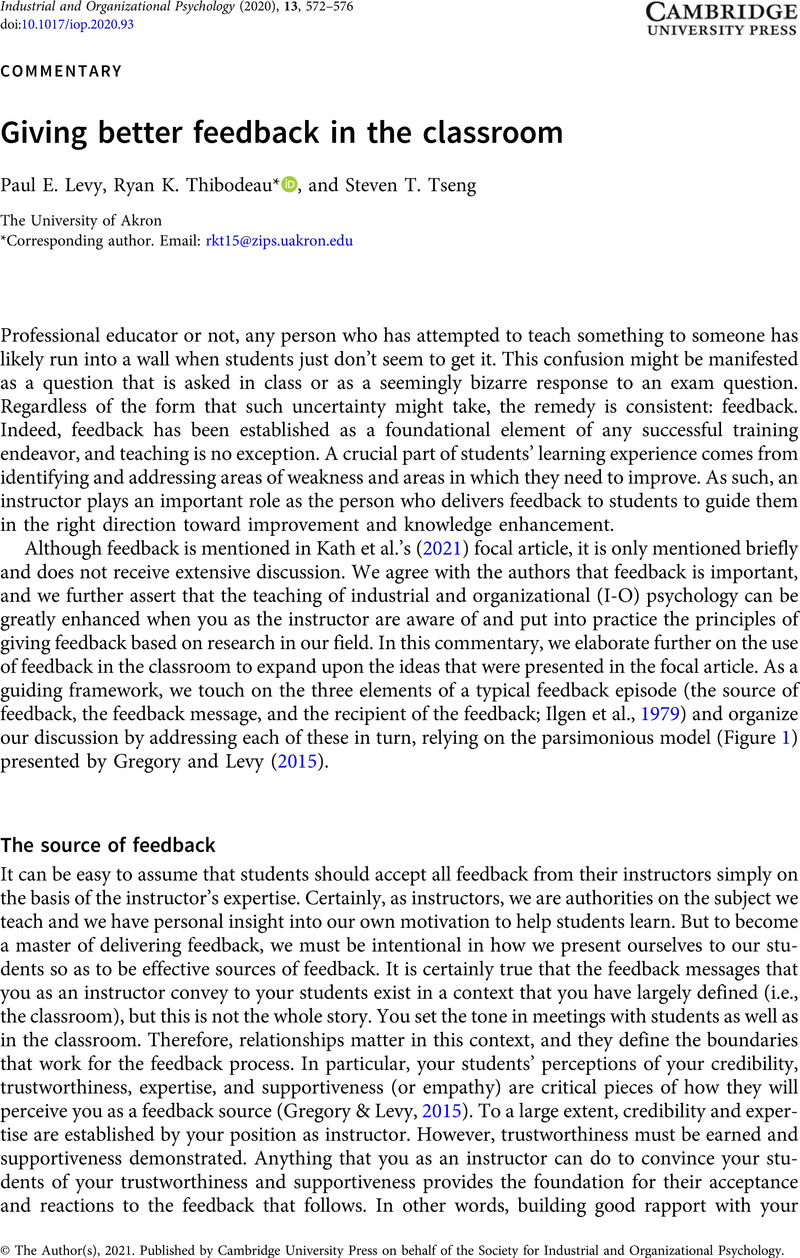No CrossRef data available.
Article contents
Giving better feedback in the classroom
Published online by Cambridge University Press: 08 February 2021
Abstract
An abstract is not available for this content so a preview has been provided. Please use the Get access link above for information on how to access this content.

- Type
- Commentaries
- Information
- Copyright
- © The Author(s), 2021. Published by Cambridge University Press on behalf of the Society for Industrial and Organizational Psychology
References
Bracken, D. W., Timmreck, C. W., Fleenor, J. W., & Summers, L. (2001). 360 feedback from another angle. Human Resource Management, 40, 3–20.CrossRefGoogle Scholar
Cox, S. S., Marler, L. E., Simmering, M. J., & Totten, J. W. (2011). Giving feedback: Development of scales for the mum effect, discomfort giving feedback, and feedback medium preference. Performance Improvement Quarterly, 23(4), 49–69. doi: 10.1002/piq.20094.CrossRefGoogle Scholar
Fleenor, J.W. (2019). Delivering 360-degree feedback. In Steelman, L.A., and Williams, J. R. (Eds.), Feedback at work (pp. 227–247). Springer.Google Scholar
Gregory, J. B., & Levy, P. E. (2015). Using feedback in organizational consulting. American Psychological Association.CrossRefGoogle Scholar
Ilgen, D. R., Fisher, C. D., & Taylor, M. S. (1979). Consequences of individual feedback on behavior in organizations. Journal of Applied Psychology, 64(4), 349–371.CrossRefGoogle Scholar
Kath, L., Salter, N., Bachiochi, P., Brown, K., & Hebl, M. (2021). Teaching I-O psychology to undergraduate students: Do we practice what we preach? Industrial and Organizational Psychology, 13(4), 443–460.Google Scholar
Kluger, A. N., & DeNisi, A. (1996). The effects of feedback interventions on performance: A historical review, a meta-analysis, and a preliminary feedback intervention theory. Psychological Bulletin, 119(2), 254–284.CrossRefGoogle Scholar
Levy, P. E., Tseng, S. T., Rosen, C. C., & Lueke, S. B. (2017). Performance management: A marriage between practice and science–Just say “I do.” In M. R. Buckley, A. R. Wheeler, and J. R. B. Halbesleben (Eds.), Research in personnel and human resources management (pp. 155–213). Emerald Publishing Limited.Google Scholar
Levy, P. E., & Williams, J. R. (2004). The social context of performance appraisal: A review and framework for the future. Journal of management, 30(6), 881–905.CrossRefGoogle Scholar
Linderbaum, B. A., & Levy, P. E. (2010). The development and validation of the Feedback Orientation Scale (FOS). Journal of management, 36(6), 1372–1405.CrossRefGoogle Scholar
Pichler, S. (2012). The social context of performance appraisal and appraisal reactions: A meta-analysis. Human Resource Management, 51(5), 709–732.CrossRefGoogle Scholar
Rosen, S., & Tesser, A. (1970). On reluctance to communicate undesirable information: The MUM effect. Sociometry, 33, 253–263. doi: 10.2307/2786156
CrossRefGoogle Scholar
Sheldon, O. J., Dunning, D., & Ames, D. R. (2014). Emotionally unskilled, unaware, and uninterested in learning more: Reactions to feedback about deficits in emotional intelligence. Journal of Applied Psychology, 99(1), 125–137.CrossRefGoogle ScholarPubMed




